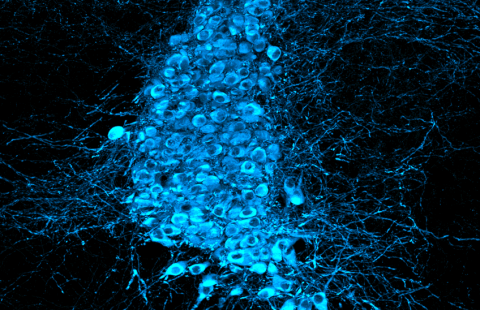Physical inactivity is a major public health problem that has both social and neurobiological causes. According to the results of an Ipsos survey published on Monday 31 December, the French have put “taking up a sport” at the top of their list of good resolutions for 2013. However, Francis Chaouloff, research director at Inserm’s NeuroCentre Magendie (Inserm Joint Research Unit 862, Université Bordeaux Ségalen), Sarah Dubreucq, a PhD student and François Georges, a CNRS research leader at the Interdisciplinary Institute for Neuroscience (CNRS/Université Bordeaux Ségalen) have just discovered the key role played by a protein, the CB1 cannabinoid receptor, during physical exercise. In their mouse studies, the researchers demonstrated that the location of this receptor in a part of the brain associated with motivation and reward systems controls the time for which an individual will carry out voluntary physical exercise. These results were published in the journal Biological Psychiatry.
©fotolia
The collective appraisal conducted by Inserm in 2008 highlighted the many preventive health benefits of regular physical activity. Such activity is limited, however, by our lifestyle in today’s industrial society. While varying degrees of physical inactivity may be partly explained by social causes, they are also rooted in biology.
“The inability to experience pleasure during physical activity, which is often quoted as one explanation why people partially or completely drop out of physical exercise programmes, is a clear sign that the biology of the nervous system is involved”, explains Francis Chaouloff.
But how exactly? The neurobiological mechanisms underlying physical inactivity had yet to be identified.
Francis Chaouloff (Giovanni Marsicano’s team at the NeuroCentre Magendie; Inserm joint research unit, Université Bordeaux Ségalen) and his team have now begun to decipher these mechanisms. Their work clearly identifies the endogenous cannabinoid (or endocannabinoid) system as playing a decisive role, in particular one of its brain receptors. This is by no means the first time that data has pointed to interactions between the endocannabinoid system, which is the target of delta9-tetrahydrocannabinol (the active ingredient of cannabis), and physical exercise. It was discovered ten years ago that physical exercise activated the endocannabinoid system in trained sportsmen, but its exact role remained a mystery for many years. Three years ago, the same research team in Bordeaux observed that when given the opportunity to use a running wheel, mutant mice lacking the CB1 cannabinoid receptor, which is the principal receptor of the endocannabinoid system in the brain, ran for a shorter time and over shorter distances than healthy mice. The research published in Biological Psychiatry this month seeks to understand how, where and why the lack of CB1 receptor reduces voluntary exercise performance (by 20 to 30%) in mice allowed access to a running wheel three hours per day.
The researchers used various lines of mutant mice for the CB1 receptor, together with pharmacological tools. They began by demonstrating that the CB1 receptor controlling running performance is located at the GABAergic nerve endings. They went on to show that the receptor is located in the ventral tegmental area of the brain (see diagram below), which is an area involved in motivational processes relating to reward, whether the reward is natural (food, sex) or associated with the consumption of psychoactive substances.
Longitudinal section of the mouse brain (top) and diagram of interactions between the endocannabinoid, GABAergic and dopaminergic systems during voluntary physical exercise (bottom) ©Inserm/F. Chaouloff
Left: stimulating the CB1 receptors excites the dopaminergic neurons in the ventral tegmental area involved in motivation.
Right: the absence of CB1 receptors lowers performance by 20 to 30% owing to reduced motivation.
VTA: Ventral tegmental area/NAcc: nucleus accumbens/PFC: prefrontal cortex/DA: dopamine
Based on the results of this study and earlier work, the Bordeaux team suggests the following neurobiological explanation: at the beginning and for the duration of physical exercise, the CB1 receptor is constantly simulated by the endocannabinoids, lipid molecules that naturally activate this receptor in response to pleasant stimuli (rewards) and unpleasant stimuli (stress). Endocannabinoid stimulation of the CB1 receptor during physical exercise inhibits the release of GABA, an inhibitory neurotransmitter that controls the activity of the dopamine neurons associated with the motivation and reward processes. This stimulation of the CB1 receptor “inhibits inhibition”, in other words, it activates the dopaminergic neurons in the ventral tegmental area. The CB1 receptor must therefore be stimulated before the exercise can go on for longer and the body must receive the necessary motivation.
Conversely, without these CB1 receptors, the “GABAergic brake” continues to act on the dopaminergic neurons in the ventral tegmental area, leading to the reduced performance levels observed above.
It is already known that CB1 receptors play a regulatory role in the motivation to consume rewards, whether natural or not. What is original about this research is that it shows that physical exercise can be added to the array of natural rewards regulated by the endocannabinoid system. “If confirmed, this motivational hypothesis would imply that the role played by the CB1 receptor has more to do with ‘staying power’ in the exercise than with actual physical performance levels” explain the researchers.
This work reveals that the endocannabinoid system plays a major role in physical exercise performance through its impact on motivational processes. It thus opens up new avenues of research into the mediators of pleasure – and even addiction – associated with regular physical exercise. “After endorphins, we now need to consider endocannabinoids as another potential mediator of the positive effects that physical exercise has on our mood,” the researchers conclude.



